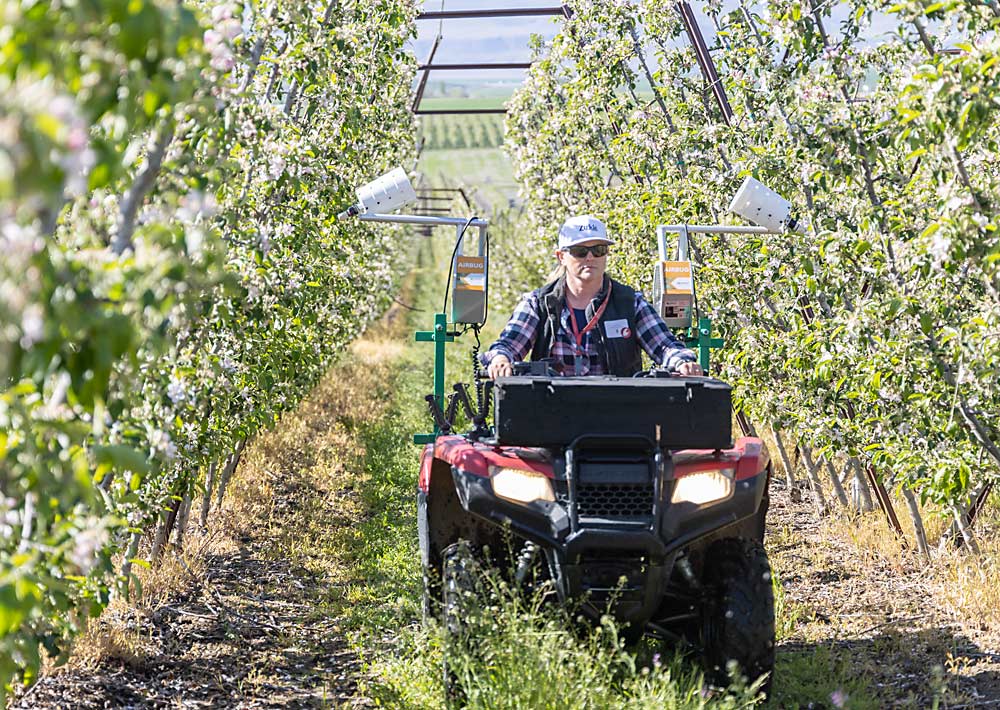
Imagine if you had a flare-up of aphids in an apple block. Instead of an insecticide, your pest consultant recommends an application of lacewings, followed by another of ladybird beetles.
This real-world example and its success converted a skeptical manager into a believer, said Teah Smith, entomologist and ag consultant for Zirkle Fruit Co. of Washington.
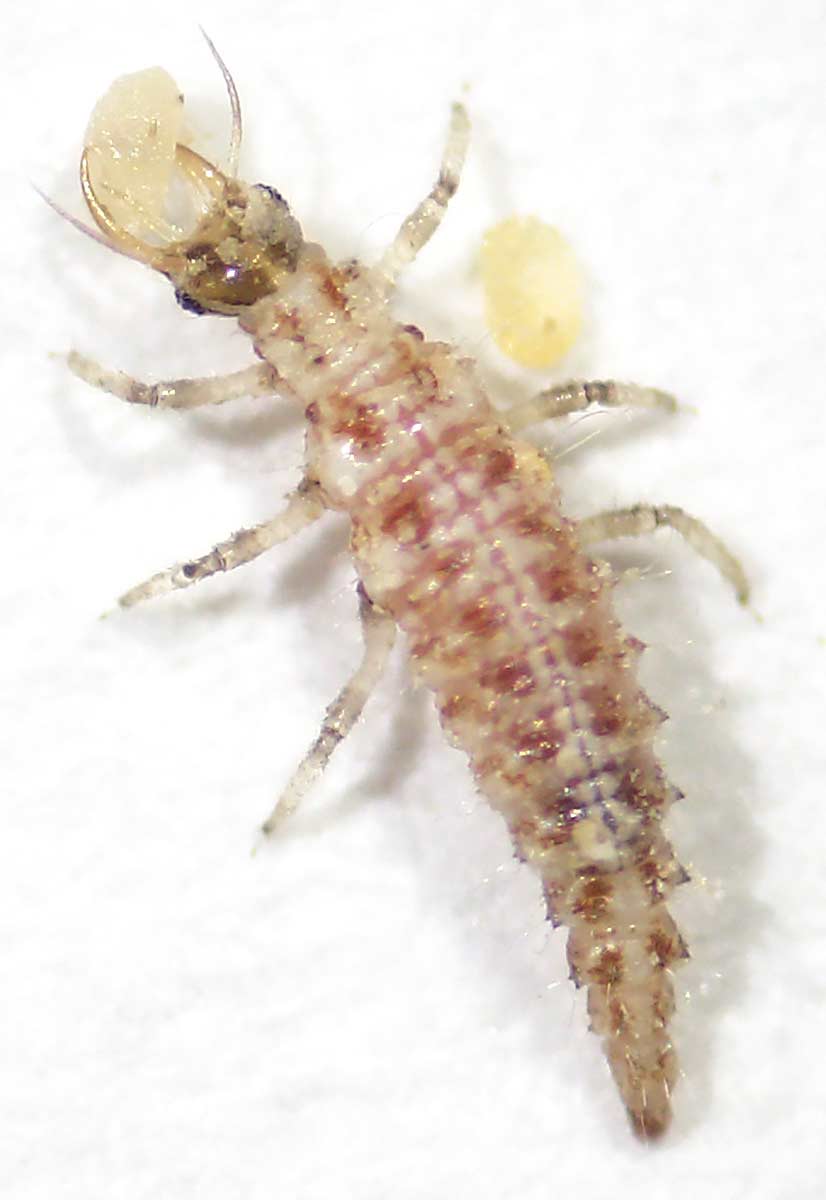
“It’s pretty fantastic to go look into the aphid colonies and see these guys doing their work,” she said.
Other organic growers aim to replicate that success, while insectaries and drone-delivery companies see new market opportunities in orchards. But under the idea of applying good bugs to eat bad ones, plenty of questions hover: How much is the success weather-dependent? What species of predator best targets a specific pest? What are optimum rates and timings? Does a drone improve delivery efficiency?
It’s a very exciting field of research, because there is a “never-ending series of questions,” said U.S. Department of Agriculture research entomologist Rebecca Schmidt-Jeffris, based in Washington’s Yakima Valley.
She compared her research to pesticide trials. If a company develops a new pesticide active ingredient, shown in the lab to kill aphids, then researchers would need to go to the field and dial in optimum rates and timings. She’s trying to take the same approach with predator insects, but it quickly gets more complicated.
“Pesticides work similarly at different temperatures and at different levels of pest pressure,” she said. Natural enemies don’t. Release adult predator beetles in an orchard without enough mealybug prey for them, and they’ll just fly off in search of greener pastures.
“You have to have enough food to support the beneficials but not so much they can’t keep up,” said Aaron Avila of G.S. Long Co., which has ramped up its efforts to support customers interested in natural enemies in recent years. “There’s so much fine-tuning that needs to be done. Success in one (location) in no way implies that the same system would work somewhere else.”
Drone-delivery, which his company now offers, attracts attention, but deploying natural enemies depends fundamentally on building a more robust integrated pest management program, he said.
“My big takeaway right now is that it’s complicated,” Schmidt-Jeffris said. While her research has yet to answer some needed questions, such as whether a labor-saving drone release can match the efficacy of hand release, she’s already ruling out some predator species and narrowing in on the stronger candidates and strategies to help releases succeed.
Most of the tree fruit industry’s prior natural enemy research focused on native species and IPM programs to protect them. The only information on the return on investment for buying and applying natural enemies currently comes from other crop systems.
“The recommended rates (from insectaries) are based on greenhouses,” said Smith, who also serves on the Washington Tree Fruit Research Commission, which is funding some of Schmidt-Jeffris’ efforts. “We need Rebecca’s work so everybody has a good idea of what the rates are and what can establish here,” she said.
Growers are also interested. Of the 130 or so who answered Schmidt-Jeffris’ survey, 28 percent had tried natural enemy release. When she asked them to identify the biggest barrier to adoption, the majority reported: “We don’t know how to do this effectively and we need more information.”
“That means I have a job to do,” she said.
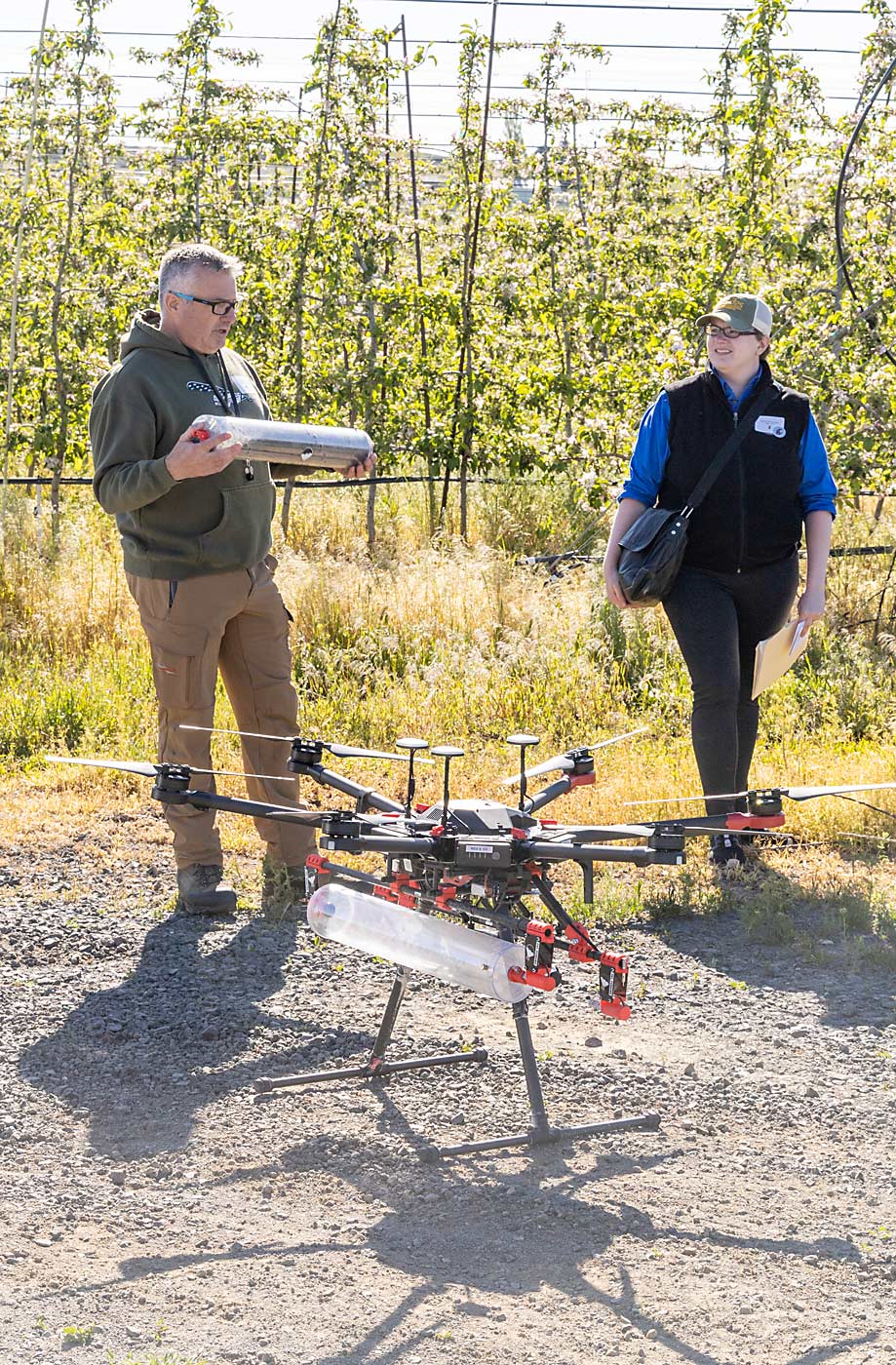
Research findings so far
In 2021 and 2022, Schmidt-Jeffris and her collaborators focused on two natural enemies: lacewings and mealybug destroyers, a lady beetle cousin with a specialized taste for mealybugs.
The trials also aimed to compare delivery methods (drone versus hand release) and see if providing additional food sources or lures could keep predators home in the orchard, thereby improving effectiveness.
“The treatments can move because they have legs and wings,” she said.
For instance, mealybug destroyers have proved a challenge — they don’t seem to stick around the orchard very long. Schmidt-Jeffris’ first season with them in 2020 looked promising, but since then, it’s been underwhelming.
“We managed to Goldilocks it our first year,” she said, but even in that scenario, the program didn’t offer enough pest control to justify the relatively high cost.
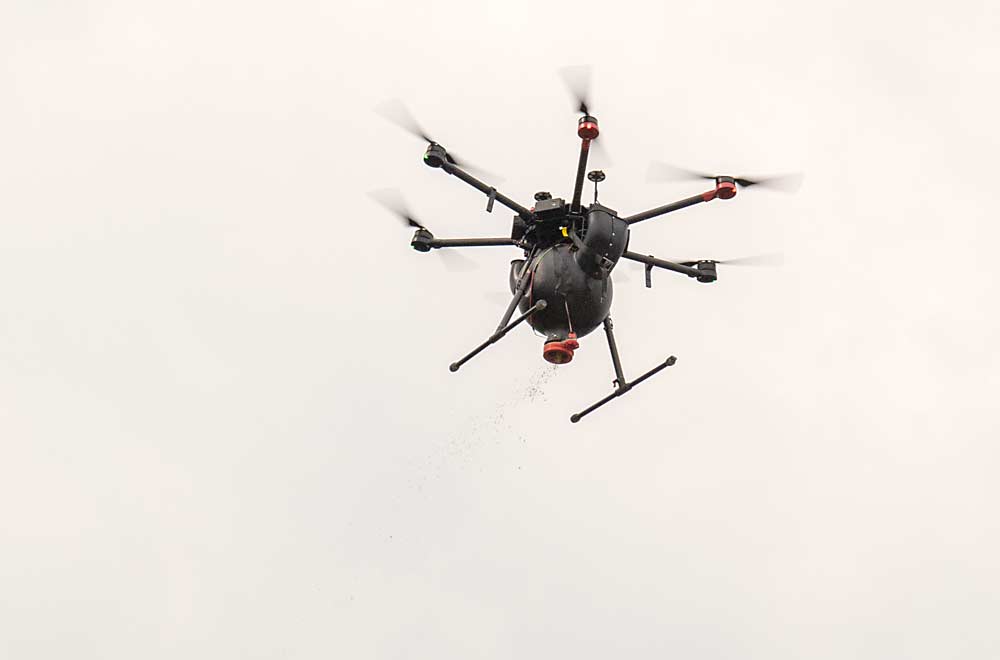
Identifying what doesn’t work is just as important for growers as what shows promise, Avila said.
Moving forward, she will focus primarily on lacewings, although Schmidt-Jeffris has her eye on a potential study of predators for thrips, spider mites and pear psylla.
“Lacewings definitely work. It’s about doing the right things” to make the releases successful, she said.
There are many species of lacewing. Some are native, others are not. Identification can be a challenge, even for insectaries, and one “species,” Chrysoperla carnea, turns out to be many similar species adapted to different climates.
“You have to rear them out to adults and then listen to them sing to each other, and I just don’t have patience for that,” she said.
Using a nonnative lacewing, C. rufilabris, is easier to identify, allowing her to monitor its presence after release.
Over the next several years, Schmidt-Jeffris expects to have findings to show which method of release works best for lacewings, as well as the optimum species, and a better understanding of the efficacy and economics.
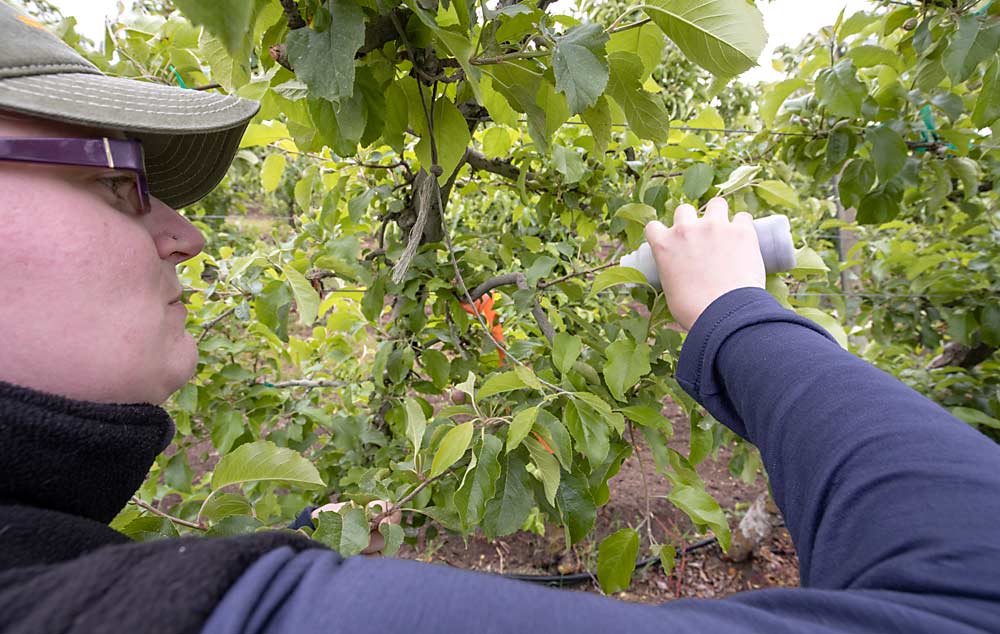
Commercial experience
While some consultants see a natural enemy application as a standalone swap for an insecticide spray, for Smith it’s part of her overall IPM approach for several ranches owned by Zirkle Fruit, one of Washington’s largest fruit companies. She wants to release native species; she builds soft spray programs; she holds off on mowing and plants refugia of native plants to encourage beneficials to make themselves at home.
“It’s very important to me that they can continue to persist in our environment,” she said. “I want what we do to be sustainable. I would like to get the ecosystem in the orchard balanced so it takes care of itself.”
She scouts weekly, looking at pest populations and natural enemy activity to decide if a spray or beneficial release is warranted, or if the abundance of natural enemies can keep things in check.
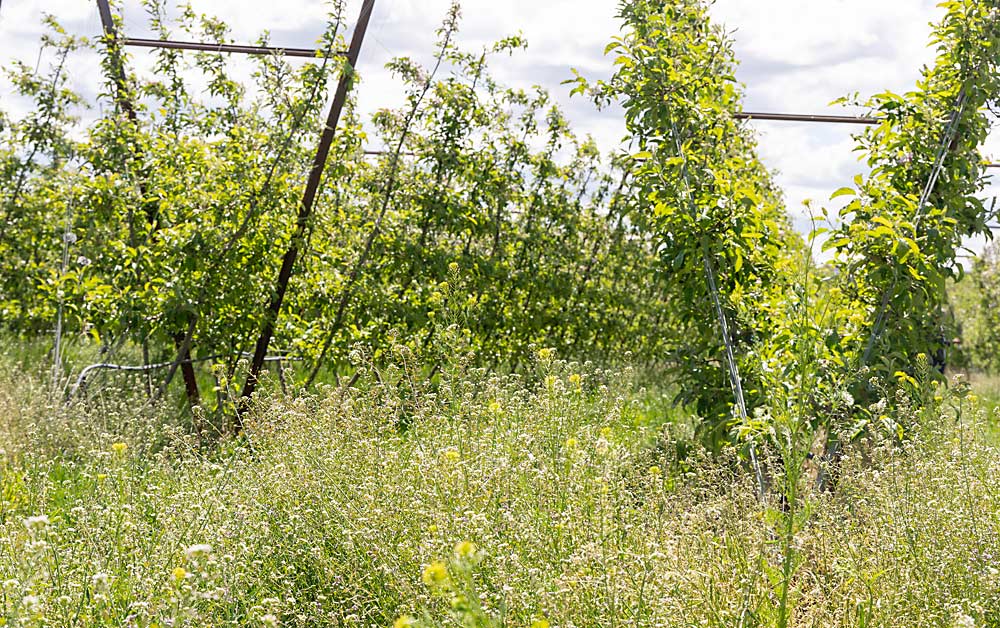
Her primary program applies lacewings and lady beetles for aphids — when she can get them. Lady beetles are wild-harvested in the Sierra Nevada mountains, so supply can vary. Smith has also dabbled in other species, including the minute pirate bug (Orius insidiosus), which tackles thrips well, and several species of predator mites. Like Schmidt-Jeffris, she was underwhelmed by the mealybug destroyers.
“They are really expensive, you can’t find them the next day, and they don’t make it through our winters,” she said.
She recommends that growers who want to try natural enemy releases check shipments on arrival for quality and scout the day after release to make sure they are finding the insects or evidence that they are cleaning up aphid colonies.
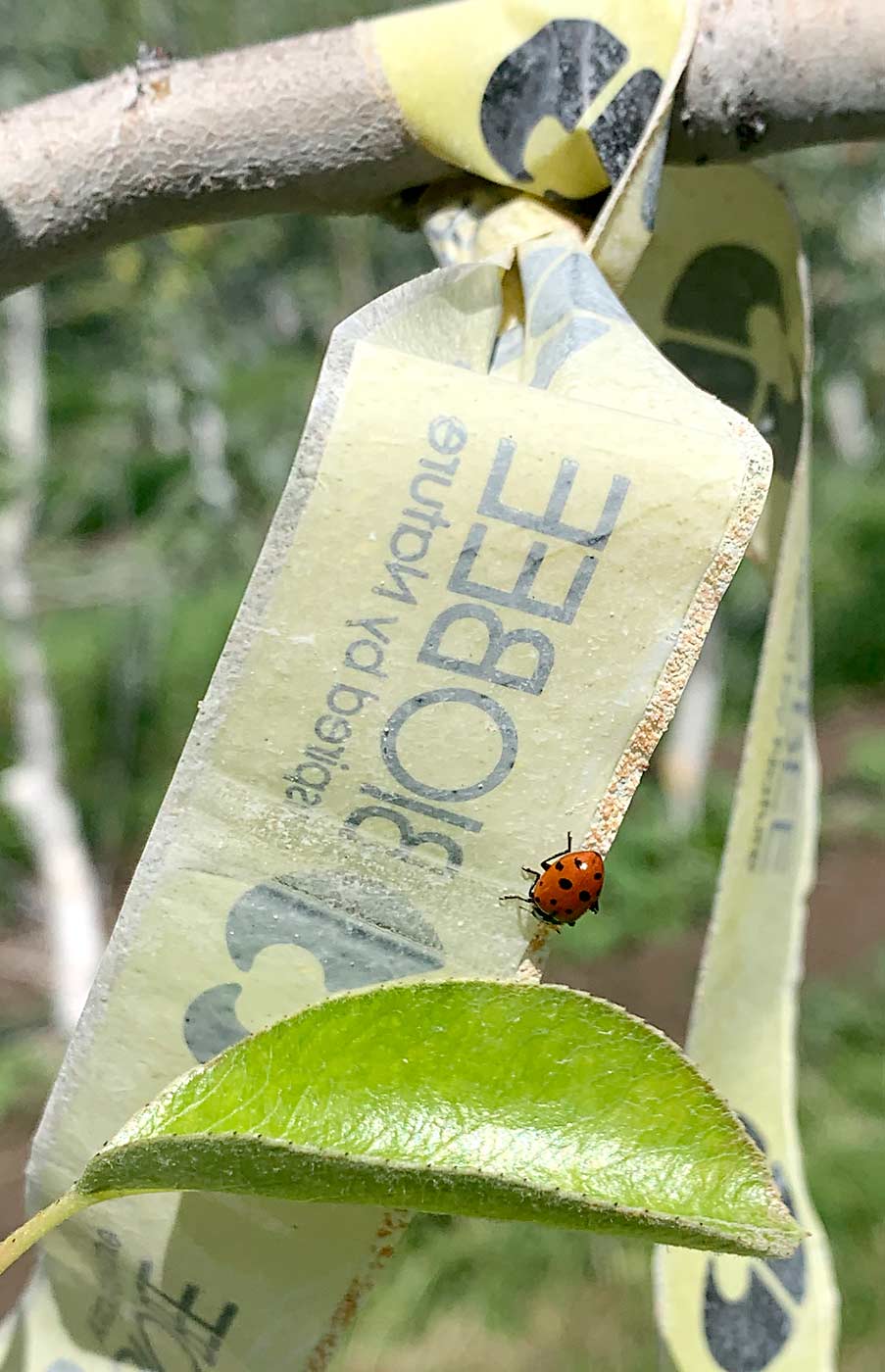
Smith also uses far lower release rates than insectaries recommend, spreading out the application over several weeks, with the goal of matching the release to the food source in the orchard.
That increases the labor cost of the application, which Smith does by hand from an ATV.
“I do like the idea of drones, because releasing is very time-consuming, but when you are spending this type of money, you want to make sure you get it right,” she said.
Before application, Smith communicates with ranch managers to make sure sprays needed for thinning or fire blight go on before she releases.
“It’s a big expense to just go wipe them out,” she said. “It requires really detailed communication between consultant and grower to make sure this is successful.”
Looking ahead
Smith and Schmidt-Jeffris hosted an Entomological Society of America tour at Zirkle Fruit orchards last summer, organized as an opportunity for scientists, insectary representatives, pest consultants and growers to talk about the potential and challenges of natural enemy applications.
The tour included release demonstrations via Parabug drone and an ATV-mounted blowing system from Koppert, a Dutch insectary. Representatives from insectaries also spoke about potential predators they’d like to see tested in orchards and the regulatory and supply chain challenges they face.
G.S. Long partnered with California-based Parabug in 2021 to use its technology for releases in Northwest orchards, vineyards and hop fields. Commercially, the company has seen more adoption in Northwest hop fields, where drone release of a native Stethorus beetle is helping to control spider mites, Avila said, although in 2022 they did significant commercial applications of lady beetles, lacewing eggs and other beneficials in orchards and vineyards.
Avila said drone release can provide labor savings, but it’s not without challenges. For example, in orchards with narrow, vertical canopies, many lacewing eggs end up in the groundcover where they are susceptible to predation.
“As a company, we are not advocating that drone release is the way to go across the board,” he said. “We’re learning. Anybody who tells you they have it all figured out is a red flag.”
Avila and Smith both warned against releasing adult beetles such as lady beetles or mealybug destroyers during the daylight, because they will fly to the sun and away from your target.
If that happens, Avila said, it’s a common, unfortunate joke: “You are releasing lady beetles for your neighbors.”
—by Kate Prengaman

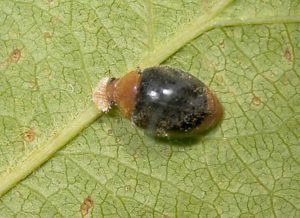
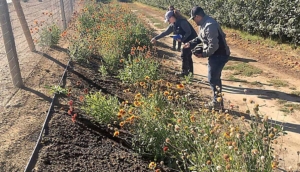





Leave A Comment